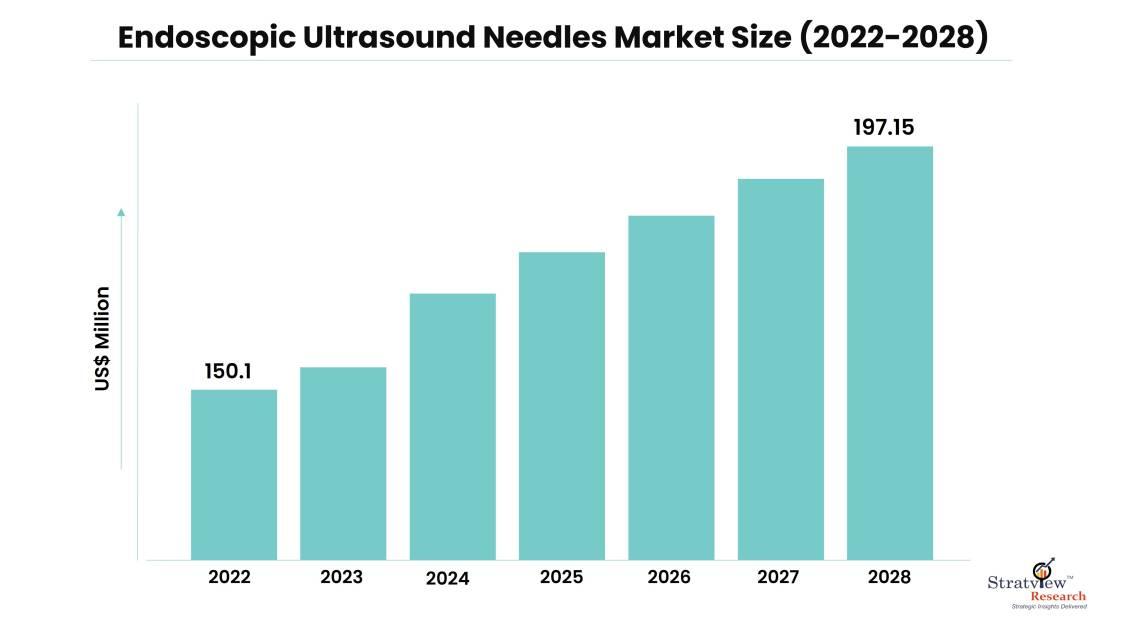Endoscopic ultrasound (EUS) is a minimally invasive procedure that uses sound waves to create images of the gastrointestinal tract and surrounding organs. EUS needles are fine, hollow tubes that are used to collect tissue samples or fluids from these organs.
The global endoscopic ultrasound needles market is expected to grow at a CAGR of 4.6% from 2022 to 2028. This growth is being driven by a number of factors, including the rising prevalence of cancer, the increasing number of diseases that require EUS procedures, and the growing geriatric population.
Market Drivers
- Rising Prevalence of Cancer: Cancer is one of the leading causes of death worldwide. EUS needles are used to collect tissue samples from organs that are at risk for cancer, such as the pancreas, the liver, and the lymph nodes. This helps to improve the accuracy of cancer diagnosis and staging.
- Increasing Number of Diseases that Require EUS Procedures: EUS needles are also used to treat a number of diseases, including pancreatitis, liver disease, and gastrointestinal bleeding. As the number of people who are diagnosed with these diseases increases, the demand for EUS needles is also expected to increase.
- Growing Geriatric Population: The global population is aging, and this is leading to an increase in the number of people who are at risk for EUS procedures. EUS needles are used to diagnose and treat a number of diseases that are more common in older adults, such as cancer, pancreatitis, and liver disease.
Market Trends
- Biopsy Needles Segment Dominates the Market: The biopsy needles (EUS-FNB) segment is the largest segment of the endoscopic ultrasound needles market. This is due to the increasing use of EUS needles for the collection of tissue samples from organs that are at risk for cancer.
- Asia Pacific Market to Grow at a Healthy CAGR: The Asia Pacific market is expected to grow at a healthy CAGR during the forecast period. This growth is being driven by the increasing aging population, the high prevalence of cancer and gastrointestinal disorders, and the growing number of testing labs for endoscopy in the region.
Market Challenges
- High Cost of EUS Procedures: EUS procedures are more expensive than other diagnostic procedures, such as ultrasound and CT scans. This high cost can be a barrier to the adoption of EUS needles in some regions.
- Limited Reimbursement for EUS Procedures: In some countries, there is limited reimbursement for EUS procedures. This can also be a barrier to the adoption of EUS needles.
Market Opportunities
- Development of Novel EUS Needles: There are a number of companies that are developing novel EUS needles. These needles are designed to improve the accuracy of cancer diagnosis and staging and to make EUS procedures more comfortable for patients.
- Growing Demand for EUS Needles in Emerging Markets: The demand for EUS needles is growing in emerging markets. This growth is being driven by the increasing prevalence of cancer and gastrointestinal disorders in these markets.
Conclusion
The global endoscopic ultrasound needles market is expected to grow at a CAGR of 4.6% from 2022 to 2028. This growth is being driven by a number of factors, including the rising prevalence of cancer, the increasing number of diseases that require EUS procedures, and the growing geriatric population. The biopsy needles (EUS-FNB) segment is the largest segment of the market, and the Asia Pacific market is expected to grow at a healthy CAGR during the forecast period.
